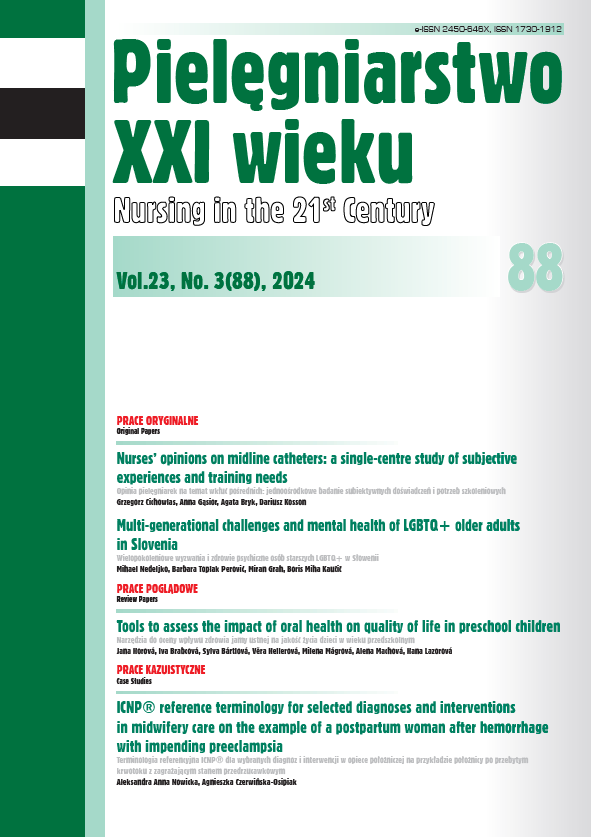Nurses’ opinions on midline catheters: a single-centre study of subjective experiences and training needs
DOI:
https://doi.org/10.2478/pielxxiw-2024-0035Keywords:
nurses, training, infusion, midline catheters, nurses’ opinionsAbstract
NURSES’ OPINIONS ON MIDLINE CATHETERS: A SINGLE-CENTRE STUDY OF SUBJECTIVE EXPERIENCES AND TRAINING NEEDS
Aim. The aim of this study is to assess nurses’ opinions on the usability, eff ectiveness, and benefi ts of midline catheters (MC) in nursing practice. Additionally, the study identifi es nurses’ subjective knowledge levels and training needs related to these catheters.
Material and methods. A cross-sectional correlational study was conducted from 15th October to 15th November 2023, involving 127 nurses from various departments. Data were collected through an anonymous survey with 13 questions about opinions on MC, subjective knowledge, and sociodemographic metrics. Statistical analysis was performed using IBM SPSS Statistics.
Results. Most nurses had experience with patients using midline catheters, and the average rating of opinions on MC was 4.44 on a Likert scale (1-5). The average subjective knowledge about MC was 4.26. A total of 88% of respondents desired future training on MC, and 72% wanted to learn how to insert these catheters. Nurses who attended training rated their preparedness to handle MCs higher.
Conclusions. Midline catheters are well-regarded by nurses and integral to their practice. Regular training and support are essential for effectively implementing new medical technologies. Investing in medical staff education is crucial for improving healthcare quality and patient safety.
References
1. Qin KR, Pittiruti M, Nataraja RM, et al. Long peripheral catheters and midline catheters: Insights from a survey of vascular access specialists. J. Vasc. Access. 2021; 22: 905-910.
2. Pittiruti M, Van Boxtel T, Scoppettuolo G, et al. European recommendations on the proper indication and use of peripheral venous access devices (the ERPIUP consensus): A WoCoVA project. J. Vasc. Access. 2023; 24: 165-182.
3. Nickel B, Gorski L, Kleidon T, et al. Infusion Therapy Standards of Practice, 9th Edition. Journal of Infusion Nursing. 2024; 47: S1-S285.
4. Latos M, Kosson D. Comparison of the efficacy of inserting midline catheters by experienced and inexperienced nurse: a retrospective observational study. Emerg. Med. Serv. 2023; 10: 224-228.
5. Latos M, Zawadka M, Kosson D. Maximum safety and minimum risk: midline access gained by a nurse-led Vascular Access and Infusion Team. Pielegniarstwo XXI wieku, Nursing in the 21st Century. 2023; 22: 125-131.
6. Latos M, Kosson D, Zawadka M. Poland’s first vascular access team 3-year analysis: Insights and learnings. J. Vasc. Access. 2024; 11297298241251502.
7. Włodek I, Sobczak A, Cichowlas G. Profil pacjentów z wprowadzonym cewnikiem pośrednim – jednoośrodkowa analiza retrospektywna. Piel. Pol. 2023; 90: 129-134.
8. Latos M, Cichowlas G, Solecki M, et al. Kaniule typu „mini-midline” w trudnym dostępie dożylnym: dwuośrodkowa analiza retrospektywna. Doniesienie wstępne. PAIO. 2022; 8: 33-36.
9. Midline Academy. (2024). Ogólnopolska Mapa Dostępu Pośredniego. Pobrano z https://www.midline.academy/ogolnopolska-mapa-dostepu-posredniego/ data wejścia:02.07.2024
10. Cichońska M, Reizer-Kucaba K, Maciąg D, et al. Poziom wiedzy pielęgniarek na temat pielęgnacji dostępów naczyniowych. Forum Zakażeń. 2021; 12: 229-236.
11. Wąsowska E, Kózka M. Opinie pielęgniarek na temat nowych technologii w opiece medycznej. Nurs. Open. 2016; 3(2): 123-130.
12. Cichowlas B. Badania opinii pielęgniarek na temat wykorzystania USG w ich praktyce. Praca magisterska. Collegium Masoviense. 2022.
13. Curtis K, Brooks S. Digital health technology: factors affecting implementation in nursing homes. Nurs. Older People. 2020; 32(2): 14-21. doi: 10.7748/nop.2020.e1236.
14. Dahm MF, Wadensten B. Nurses’ experiences of and opinions about using standardised care plans in electronic health records – a questionnaire study. J. Clin. Nurs. 2008; 17(16): 2137-2145. doi: 10.1111/j.1365-2702.2008.02377.x.
15. Booth R, Sinclair B, Strudwick G, et al. Stemming the tide: A mobile health strategy to support nurse adoption of continuous vital sign monitoring technology. Int. J. Nurs. Stud. 2021; 117: 103884.
16. Leenen JPL, Dijkman EM, Van Hout A, et al. Nurses’ experiences with continuous vital sign monitoring on the general surgical ward: a qualitative study based on the Behaviour Change Wheel. BMC Nurs 2022; 21: 60. https://doi.org/10.1186/s12912-022-00837-x.
17. Shields R, Latter K. Improving the uptake of medical device training to promote patient safety. J. Med. Educ. 2019; 5(1): 10-20.
18. Hennessy KA, Dynan J. Improving Compliance With Personal Protective Equipment Use Through the Model for Improvement and Staff Champions. Clinical Journal of Oncology Nursing. 2014; 18: 497-500.
19. Al-Surimi K, Al-Qahtani S, Ali A, et al. Reporting of adverse events in medical devices in King Saud University Medical City. Saudi Med. J. 2020; 41(1): 37-43.
Downloads
Published
Issue
Section
License
Copyright (c) 2024 Authors

This work is licensed under a Creative Commons Attribution 4.0 International License.




